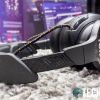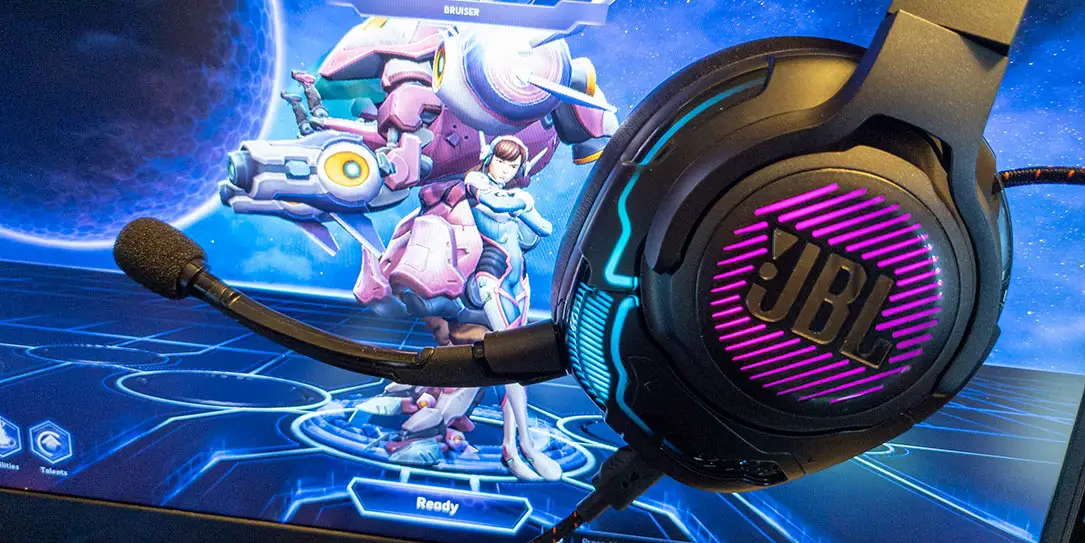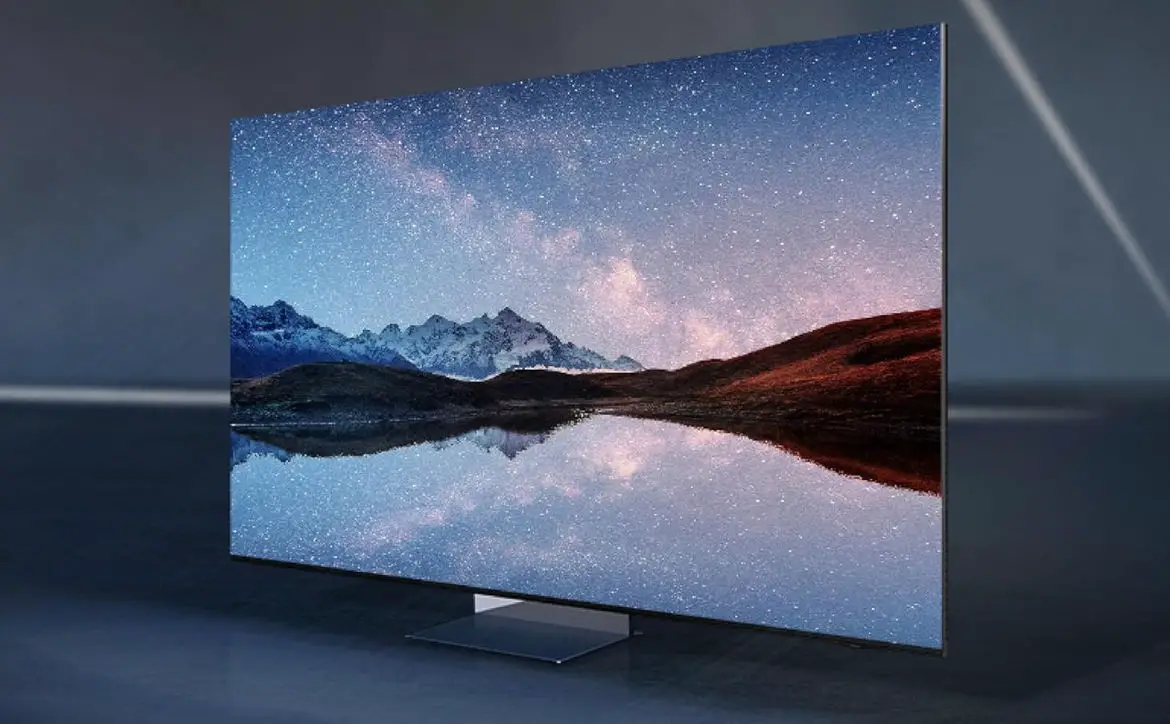![[UPDATED] JBL Quantum ONE review: Great sounding flagship gaming headset with head tracking 1 Techaeris Rated 9/10](https://techaeris.com/wp-content/uploads/2017/03/TA-ratings-90.png)
We caught our first look and listen to JBL’s new Quantum gaming headset lineup back at CES 2020. A reputable consumer audio brand, making the leap into gaming was only logical for the company. At CES, we were given a brief demo of the JBL Quantum ONE gaming headset which features the company’s QuantumSPHERE 360 sound technology and integrated head tracking sensors for truly immersive gameplay.
I’ll admit, I was blown away by the demo and wanted to stick them in my backpack right then and there. here we are a few months later and we’ve finally had a chance to give the headset a proper review. As such, our JBL Quantum ONE review takes a look at the flagship of the gaming headset line which features 7.1 surround sound audio with head tracking sensors. Read on for our full review!
Table of contents
Specifications
The JBL Quantum ONE gaming headset has the following features and specifications:
- Get the professional edge with head tracking enhanced JBL QuantumSPHERE 360™
- Be at the center of the game with Hi-Res certified JBL QuantumSOUND Signature
- Next-gen ergonomic design
- Active Noise Cancelling tuned for gaming
- Be heard with the voice focus detachable boom mic
- Game-chat balance dial
- Seamless compatibility with all gaming platforms (PC, Xbox, PlayStation, Switch, mobile, Mac, VR)
- Powerful JBL QuantumENGINE PC software suite customization
- Spatial sound setting
- Audio equalizer for custom sound
- RGB effects tuner
- Microphone setting
- Manage user profiles & settings
| Driver Size | 50mm Dynamic drivers |
| Frequency response | 20Hz – 40kHz |
| Microphone frequency response | 100Hz – 10kHz |
| Max input power | 20mW |
| Sensitivity | 95dB @ 1kHz, 1mW |
| Maximum SPL | 97dB |
| Microphone sensitivity | -41dBV @1kHz/Pa |
| Impedance | 32 ohm |
| Microphone pickup pattern | Unidirectional |
| Microphone size | 6mm x 2.7mm |
| Weight | 369g (0.81lb) |
What’s in the box
- JBL Quantum ONE headset
- 3.5 mm audio cable
- Calibration microphone
- Detachable boom microphone
- Windshield foam for microphone
- Type-C to A cable with Game/Chat Balance Dial
- Quick Start Guide
- Warranty card
- Safety Sheet
Design
JBL’s first stab at gaming headsets succeeded in the looks department. The JBL Quantum ONE gaming headset has a quite aggressive gaming look. These wired over-the-ear headphones are bulky looking, but in a good way.
The headband is roughly 1 3/4-inches wide with some detail lines and the JBL logo stamped into it. On the underside, about 3/4-inch of memory foam lines the inside. The center of the underside has a bit of extra memory foam thickness with two smaller areas to the left and right having a little extra cushioning as well. On either end of the headband is the adjustable arms that connect to the earcups.
The earcups are attached to the headband with an inverted Y piece which swivels and tilts. The eacups swivel forward a full 90° and back/out roughly 30°. As far as the tilt is concerned, using the top of the earcup as a reference point, they tilt out roughly 10° and in roughly 30°. Between the swivel and tilt, you should get a pretty comfortable fit for your head size and shape.
The outer earcups are adorned with a cog-shaped centerpiece with the JBL logo stamped in silver in the middle. The rest of this centerpiece has thin diagonal lines that display the first RGB lighting zone. The centerpiece is attached to a much larger and oval-shaped piece. Constructed of transparent black plastic, the second RGB strip snakes its way around the outside. Flattened at the bottom, the third, and final, RGB zone consists of a series of slanted lights towards the front bottom of the outer ear cup.
The outer edge of the earcups both have an ANC microphone near the back and a braided black wire with orange accents connecting from the back top through the headband. The left earcup is where you’ll find all your onboard controls. All located on the back, these include (from top to bottom):
- ANC/Talkthru LED
- ANC/Talkthru button
- Re-centering button for head track
- The aforementioned ANC microphone
- Volume control wheel
- Microphone mute/unmute button
- Power status LED
- USB Type-C port
- 3.5mm audio jack
- Boom microphone jack for detachable boom microphone
The detachable boom microphone is also thicker and almost futuristic looking. It is easily bendable for better placement and appears to stay in place fine once adjusted. A windshield foam piece is included to place over the end of the microphone for better microphone audio quality.
Finally, as far as the gaming headset design, the inside of the earcups is lined with a faux leather memory foam which is quite thick. It is rather comfortable around the ears. On the inside of each earcup is an orange L or R on the semi-transparent material to indicate which earcup goes on which ear. With the semi-transparent material used on the inside, you can see the 50mm drivers which is a fun little touch. If you wear glasses, however, they aren’t the most comfortable as the earcups tend to press the arms against the sides of your head.
The JBL Quantum ONE includes two cables. Both are black braided cables with orange accents. The first is a USB Type-C to USB-A cable for use with a PC desktop computer or laptop. The second is the 3.5mm audio cable for use with game consoles or mobile devices. The USB cable is very long, coming in at around 9 feet. At about 5 feet from the USB-A plug (which goes into your computer), is a round control disc roughly 3-inches in diameter. This control unit allows you to adjust the balance between game and chat volume. The 3.5mm cable, on the other hand, is 4 feet in length. It also has an inline control for volume and microphone mute toggling. While not included, you can also use a USB-C to USB-C cable for supported devices.
One thing I noticed about the headset after wearing it for extended gaming sessions is that it is a bit heavier than others I’ve tried in the past. (un)Thankfully, I’m not into marathon gaming sessions lately and usually average an hour or two per session. Still, at around the two hour mark, I definitely felt a bit of tension in my neck due to the weight of the headphones.
Ease of Use
When using with another device, like a mobile phone, console, or anything with a 3.5mm audio jack, it’s as simple as using the included 3.5mm audio cable.
When first plugged into a PC, the JBL QuantumENGINE download prompt appears. You’ll definitely want to install this in order to take full advantage of the JBL Quantum ONE gaming headset. After installation, you’ll need to restart your PC. Once restarted, opening up the QuantumENGINE app will present you with the various configuration options which you can then play with.
Clicking on the QuantumSPHERE 360 audio option will then open your system audio settings and launch a web browser with a YouTube video showing you how to further configure your headphones. It is rather simple, but it is an extra step that needs to be taken.
If the sound properties aren’t open, type Sound into your Windows search bar and select the Change system sounds option. You can also type mmsys.cpl and select the control panel item as well. Next, select the Playback tab and make sure the JBL Quantum ONE* Game is selected as your speakers (not headphones). Next, right click and select Configure speakers. Choose 7.1 Surround (as it’s likely defaulted to Stereo) and in the next two screens, make sure all 7.1 channels are selected. Click finish. You can then return to the software for further configuration, including HRTF calibration.
Once configured and set up, you can also control certain functions from the left earcup itself. These include being able to toggle ANC on and off, re-centering for head tracking, increasing and decreasing master volume, muting and unmuting the microphone, and turning the JBL Quantum Lighting on or off.
Software
Software… as mentioned above, when you first plug in the JBL Quantum ONE gaming headset to your computer, you are prompted to download the JBL QuantumENGINE Windows application. Like most peripheral device applications, QuantumENGINE lets you adjust the equalizer settings, lighting, spatial sound, microphone, update software/firmware, and even has link to the manual and FAQs.
JBL attempted to make the interface futuristic and trendy and, to be honest, it looks kind of dated. It’s not that it doesn’t work but something just looks and feels off about it. On the home page, you are shown quick settings across the top including volume, microphone activity, game/chat balance, spatial sound toggle, head tracker toggle, and quick access to re-centering the headset. Just below this on the far right is an option to save or edit the current profile. Underneath this is a red outline of your headset positioning. As you turn your head around, the headset on-screen follows so you can see the orientation.
Along the left side are your rectangular option buttons. From top to bottom these are Equalizer, Lighting, Spatial Sound, Microphone, System Software, and Help. For Equalizer options, you can choose between Bass Boost, Bass Cut, Clarity, Flat, FPS, High End Boost, or Long Session. In addition, you can copy a preset then adjust 10 frequency sliders to fine-tune your preferred audio settings.
The Lighting tab lets you toggle the RGB lighting on or off, as well as set the colours for the three different zones. Not only can you set the colours but you can set multiple colours for each zone and adjust how long they cycle. It’s a bit clunky to do but once you’ve played with it for awhile, it’s not that bad overall.
Spatial Sound is the section you’ll definitely want to hit up. Here you can choose between QuantumSPHERE 360 or DTS, or turn spatial audio off altogether. With QuantumSPHERE, you do have to specify your head size which, if you want an accurate sound stage, you’ll want to do. You can choose S/M/L or go into the Advanced Mode and set your height and head diameter. I was skeptical at first but you can notice a slight difference as you adjust both of these. Finally, you can check the channel setup as well as start the HRTF calibration. To do this, you’ll need to unplug the microphone, plug the calibration mic into the headset, and place the included calibration mic into your left ear. After it runs a few tests, it will prompt you to move the mic to your right ear. Once done, it will generate an HRTF profile for you and let you compare it to the default settings. Personally, I liked the default settings even after I ran the HRTF calibration twice.
Net, the Microphone tab lets you see the current mic level, set the mic volume, and adjust the sidetone level (0/1/2/3). As I’ll discuss further below, there are some drawbacks to enabling sidetone on this headset.
Finally, the System Software and Help sections are pretty self explanatory. The first allows you to check for QuantumENGINE updates or firmware updates for the headset itself. When I first received the headset, there was a firmware update and it was sent another one recently which I imagine cleared up some of the earlier issues other reviewers encountered.
Sound Quality
Regardless of looks or lighting options, sound and microphone quality need to be top-notch for any gaming headset. With Spatial Sound on, the 50mm dynamic drivers used in the JBL Quantum ONE sounds fantastic with its 7.1 Surround Sound soundstage. Positional audio while gaming is fantastic and the audio is pretty balanced across lows, highs, and mids. Personally, I liked the Bass Boost EQ setting the best to get that little extra bass out of the headset.
The active noise cancelling works great as well. When turned on, I can barely hear ambient noises around me like the dishwasher or people talking. And that’s with no audio playing through the headset. Once you start gaming or listening to music, all outside sounds are easily drowned out. I played a number of games with the headset including Forza Horizon 4, Gears 5, Apex Legends, and Heroes of the Storm. In all cases, the sound stage was amplified with the sounds of roaring cars coming for all directions, or battlefield sounds having a more precise location. The location aspect especially came in handy for Apex Legends and Gears 5. There was a couple of times where I wanted to turn my head around to see who was coming. Funny enough, when I did, the audio from behind me moved towards my right ear because I had the head tracker feature turned on.
Head tracking. While we were at CES, we had a quick demo of the feature. And it blew me away personally. Sitting in a chair, staring at a huge screen, and as you turn your head, the sound in front of you stays located in it’s position. Put another way, if someone is shooting at you from directly in front of you and you turn your head to the left, the gunfire moves more towards your right ear. Turn your head right and the gunfire fills your left ear. Turn around completely and the gunfire moves behind you. In other words, the in game and computer audio stays in place in relation to the events on the screen and not the position of your head, just like it would in real life.
So here’s the thing. While the headset sounds great with 7.1 surround sound audio and the head tracking positional audio works as advertised, it’s best suited for large monitors. I tested the Quantum ONE on a 15.6-inch laptop, 17-inch laptop, the 27-inch MSI Optix MAG272CQR, the 32-inch Samsung Odyssey G7, and the whopping 49-inch Samsung Odyssey G9.
On the laptops, you’re not moving your head that much so the head tracking doesn’t really come into play. When you have a second monitor setup, you can hear the audio staying centered on the main screen but no one is really gaming that way. On the 27-inch MSI Optix MAG272CQR with its 1500R curvature, the same thing pretty much applied. When it came to the 32-inch Samsung Odyssey G7 with its 1000R curvature, the head tracking did finally start to come into play. I also tried on a 32-inch Monoprice 4K monitor with no curve and, again, the head tracking did come into play slightly as well.
However, the JBL Quantum ONE really shone with the 49-inch Samsung Odyssey G9. Every game I played on that beast with its 1000R curvature and 5120 x 1440 benefited from the head tracking. Due to the size of the monitor, which is immersive enough visually, I was constantly scanning left and right depending on the game I was playing. With shooters, it really does make a difference when you hear footsteps behind you and you turn your head to the left and you can hear them filling your left ear, confirming a more precise location. Not only during gameplay but cutscenes are much better when you can turn your head to look at something in the upper corner and the audio stays centered on the screen. At first, it was actually kind of trippy because it really does mimic real life.
During my review period, there was only one instance when I had to re-center the head tracking. There are two ways to do this. The first, and more accurate, is through the app. Of course, mid-game you’re not going to do this. The second, and easier, way is by looking at the center of your monitor and pressing the re-center button on the left earcup. The voice prompt will indicate it’s recentering and then confirm when your headset is centered again.
In summary, the 7.1 surround sound Spatial Audio while PC gaming with the JBL Quantum ONE is absolutely fantastic — especially if you have a larger monitor and can enjoy the head tracking feature as well. Unfortunately, both of these are lost on other systems but in those cases, the audio was decent and balanced enough.
Microphone Quality
During initial testing, the microphone quality seemed o.k. However, I’m one of those gamers who have to hear myself through my headphones when I talk. As soon as I enabled sidetone to do so, and it worked rather well, ANC automatically turned off. Besides losing ANC, the microphone quality seemed to go down a bit as others in the session commented that I sounded hollow, tinny, and even had a bit of an echo at times.
UPDATED (09/23/2020): With a couple of recent firmware updates, the microphone quality has improved on the Quantum ONE. In recent online matches, when asked, the other people in my group said I sounded just fine and was coming through nice and clear. As such, we’ve updated our score in this section to reflect that improvement.
Price/Value
At US$299.99, the JBL Quantum ONE is right up there with some of the more advanced and expensive gaming headsets on the market. This really is a tough one for me as they do sound fantastic and the head tracking is a neat feature — if you have the monitor size to support it. If you’re primarily a PC gamer and do have a larger monitor, you’ll definitely want to consider these.
Wrap-up
The JBL Quantum ONE is a great sounding 7.1 surround sound gaming headset. The head tracking feature works great if you have a large monitor to make it a worthwhile feature for PC gaming. That said, there are tradeoffs as it is on the expensive side, is a bit heavy, and the microphone works better without sidetone turned on which may bug some gamers. JBL is definitely on the right track with their first foray into gaming and hopefully their next iterations can be fine-tuned in a couple of areas, most notably weight and microphone quality. If the Quantum ONE doesn’t seem like the headset for you, there are other more affordable JBL Quantum gaming headsets to suit other budgets and needs as well.
In some of our articles and especially in our reviews, you will find Amazon or other affiliate links. As Amazon Associates, we earn from qualifying purchases. Any other purchases you make through these links often result in a small amount being earned for the site and/or our writers. Techaeris often covers brand press releases. Doing this does not constitute an endorsement of any product or service by Techaeris. We provide the press release information for our audience to be informed and make their own decision on a purchase or not. Only our reviews are an endorsement or lack thereof. For more information, you can read our full disclaimer.
Last Updated on July 21, 2023.

![[UPDATED] JBL Quantum ONE review: Great sounding flagship gaming headset with head tracking 2 What's included with the JBL Quantum ONE gaming headset](https://techaeris.com/wp-content/uploads/2020/07/JBL-Quantum-ONE-review-01.jpg)
![[UPDATED] JBL Quantum ONE review: Great sounding flagship gaming headset with head tracking 3 The JBL Quantum ONE gaming headset](https://techaeris.com/wp-content/uploads/2020/07/JBL-Quantum-ONE-review-03.jpg)
![[UPDATED] JBL Quantum ONE review: Great sounding flagship gaming headset with head tracking 4 Headset controls are located on the back of the left earcup on the JBL Quantum ONE gaming headset](https://techaeris.com/wp-content/uploads/2020/07/JBL-Quantum-ONE-review-16.jpg)






![[UPDATED] JBL Quantum ONE review: Great sounding flagship gaming headset with head tracking 5 The earcups and earpads on the JBL Quantum ONE gaming headset](https://techaeris.com/wp-content/uploads/2020/07/JBL-Quantum-ONE-review-11.jpg)



















